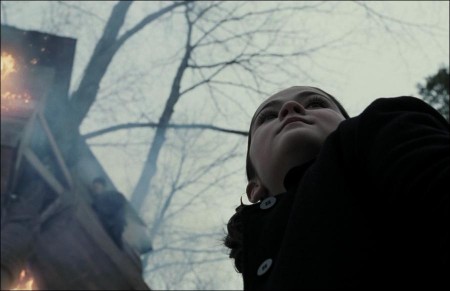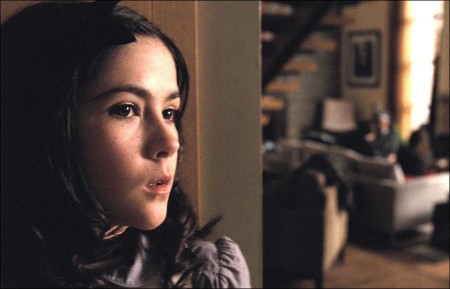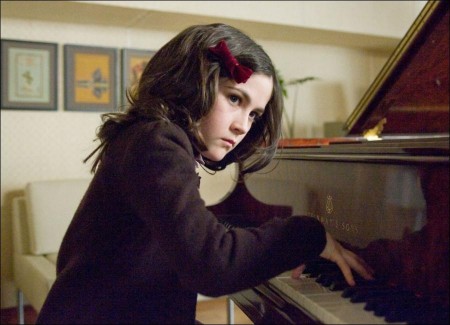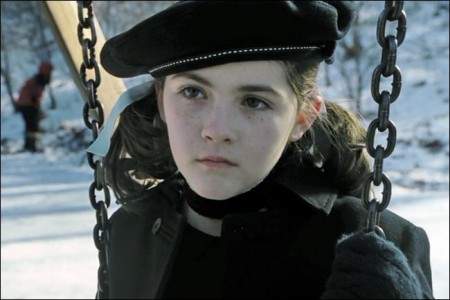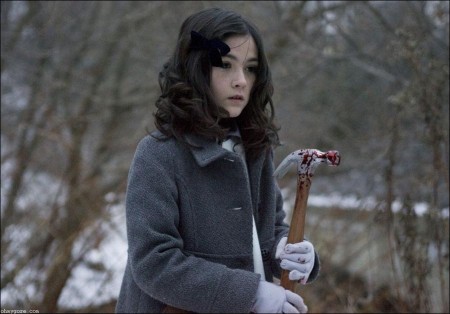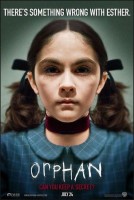About the Production
Can you keep a secret? After a series of difficulties in their marriage, culminating with the loss of an unborn child, Kate and John Coleman, who have a son and daughter, decide the best way to heal is to add to their family by adopting a nine-year-old girl. Esther recently experienced the loss of her previous adoptive family in a house fire, from which she only narrowly escaped herself.
Director Jaume Collet-Serra, who previously directed the horror film “House of Wax” for producers Joel Silver and Susan Downey, describes Esther as “very mysterious, but at the same time, she seems very smart, very creative. Kate and John, the adoptive parents, want a child who is special. And they definitely get somebody who is really, really special,” he smiles.
Almost as soon as they welcome Esther into their home, however, an alarming series of tragic events begins to unfold, leading Kate to believe that something isn’t right-this seemingly angelic little girl is perhaps not what she appears to be.
“I think a villain like this is interesting to watch,” states producer Joel Silver. “You wouldn’t want to see her in the real world, but it’s fun to see her in a movie. She’s a psychopath in the shape of a little girl who will stop at nothing.” In fact, it doesn’t take long to realize that there really is something wrong with Esther. Producer Susan Downey relates, “Kate and John were ready to put their lives back on track, and they decided to adopt an older child. To fit in with the kids that they already had, they wanted to find one somewhere between their older son and their younger daughter, and hopefully have a really happy little fivesome.” But there’s something about Esther that they don’t know.
When John first happens upon her, Esther is singing sweetly and painting a beautiful picture. Kate joins them and the couple quickly find themselves drawn in by Esther’s intelligence and her singular point of view. Conservative and shy, Esther is clearly a unique little girl. Kate, a musician, and John, an architect, easily see this exceptional child fitting into their family, despite-or perhaps even because of-her tragic past.
Collet-Serra observes, “Esther is welcomed into the family, but soon after her arrival we see that she’s not as innocent as she seemed. In a film, when you have an evil kid who does evil things, you start small and more subtly than you might expect in a horror movie. Little things start happening, and before you realize it you have an enemy inside the house, this little girl manipulating the situation.”
The current state of the Coleman family is ripe for manipulation. Kate, still healing from her loss, is a recovering alcoholic, and her drinking has led to near-tragedy in the past when their daughter Max nearly drowned on her watch. John continues to fight the urge to blame his wife for what might have happened. The fractures in their relationship run deep, making them vulnerable and giving Esther an opportunity.
Leonardo DiCaprio, a partner at Appian Way and a producer on the film, states, “We were as excited as we were about the project because it felt like so much more than your typical genre film. A lot of its appeal has to do with the fact that there is a complex psychological drama playing itself out alongside the typical genre scares.”
Actress Vera Farmiga, who stars as Kate, remarks, “This story puts a new spin on the genre. It’s not just bloodletting; it’s horrifying events happening to real people with real problems. Events make you shudder and say, `Thank God that’s not happening to me!’”
Peter Sarsgaard stars as Kate’s husband, John. The actor also appreciated the realistic base to the story. “At its core, this is a family that was broken. Kate has extreme guilt over Max’s accident, the drinking, and even the stillbirth. Despite trying to get past all of that, John’s still not sure he can trust her, and even blames himself. Esther comes in and shines a light on these things, and uses them to her advantage. I think the best horror movies highlight the human condition and play on the fears and problems so many of us are faced with in our own lives.”
Working from a story by Appian Way’s Alex Mace, screenwriter David Leslie Johnson wrote the script. “David’s screenplay delivered,” attests Silver. “He really made the story and the characters come to life.”
For Johnson, it was a labor of love. “I’ve loved the genre ever since I saw `The Bad Seed,’” he notes. “It’s one of my favorite horror sub-genres-the evil child.
There’s something very visceral to it. Viewers have a strong reaction, whether it’s a child being corrupted by the devil, or whether it’s just a bad kid…we’re very knee-jerk in our reaction to it. And I didn’t want to do it in a way that it had been done before. I wanted to find a new way into it, to bring a new angle to the subject matter. I came up with the twist at the end, the secret, and sort of worked backward from there.”
“David’s script was great,” says Collet-Serra. “The characters were so welldeveloped. I really saw the potential of making a movie that had all the elements: great acting, great atmosphere, tension, not to mention really scary. `Orphan’ is really a psychological thriller that turns into a horror movie. It’s not straight horror. The whole story revolves around this secret, and it’s very rare for me to read a script and be completely surprised by the ending. It was so believable. That’s what got me hooked on it.”
Silver adds that, while audiences will recognize that there’s something different about Esther, “I want them to have that shock, that never-saw-it-coming moment. I want them to leave the theatre talking about it the same way we did when we read the script.”
“David created characters that we could really invest in,” says Downey. “Kate and John are a couple that I think people can relate to, because they’re very flawed. But their back stories aren’t thrown out there as a crutch or just something to give the characters depth. That’s what set this script apart for me-the realistic component of these people who we are investing in and believing in, just falling apart. And then there’s this really surprising twist…”
Producer Jennifer Davisson Killoran agrees. “From its inception, I felt this story was fantastic fun. It keeps you guessing, and just when you think you know what the secret is, it throws another curveball and you’re not sure.”
In addition to the thriller aspects of the film, Killoran was also drawn to the mother-child relationships at the heart of the story. “I think Kate is a wonderful portrayal of a woman trying desperately to do right by her children, whether biological or adopted. She just wants the best for them.”
“There’s just something really primal in that mother-child relationship,” says Johnson, “so I felt like that was really the best relationship to exploit and corrupt; to take what should be the most natural bond in the world and turn them into enemies. And I gave the mother a troubled background so that when she starts saying there’s something wrong with Esther, everyone has reason to doubt her because she’s not the most reliable person.”
However, Johnson credits the director with “making it not only scary, but also bringing a sense of menace and mood to the family scenes. Even early on, when things haven’t gone wrong yet, there is this feeling that something is going to go wrong, and that has a lot to do with the way.”
“To be great, a thriller has to be smart; it has to have fresh ideas,” offers Silver. “And for it to really work it has to have suspense, and it has to take you on a journey. And Jaume does that brilliantly. He’s a really patient storyteller who takes his time in luring an audience in.”
“I wanted to portray a family that has good moments and bad moments. I didn’t want to put a finger on their pain from the very beginning; I wanted to see why they were together, to give them a chance for a happy ending,” Collet-Serra says. “Then, as things start to really go wrong, we see, just for a moment, the actual act of violence. The key for me is to show it in a very real but brief way, emphasizing the story and the performances.”
There’s nothing wrong with being different, you know… Vera Farmiga plays Kate, a wife and mother and recovering alcoholic who recently endured a stillbirth in her third trimester. “She has a gaping hole in her womb and in her heart,” says Farmiga, “but she’s trying to persevere and to heal her marriage and her family. Her choice to adopt is an act of kindness. She needs to do something with all the love that she had in her heart for that child…to give it to somebody in need. Adoption is a way to heal and draw her family closer together again.”
Kate is also a gifted pianist. We learn she had a career teaching at a prestigious music school, and she gave that up to raise a family. But her son couldn’t care less about music and her daughter is profoundly deaf and can’t hear it. However, the biggest impact on her was the loss of a child, followed by Max’s terrible accident, a near-drowning she could have prevented had she not been drinking.
But no matter how far they’ve come in the healing process, her husband can’t help but blame her and she can’t truly forgive herself. The guilt and the lack of trust have driven a wedge between Kate and John, which is made much deeper by the arrival of Esther, who exploits Kate’s failings and John’s doubts.
“Kate has been on a difficult journey,” notes Silver. “She lost a child in childbirth. She’s an alcoholic, and she almost lost another one of her children because of it. She’s tortured. But she’s really tried to clean up her life and she’s ready to move on, when she brings this little girl into her life, and that sends her back into a tailspin.”
Farmiga says she researched her part by “spending time on grief websites, reading stories about women coping after the loss of a baby. It’s no small feat to put back the pieces of a broken heart after experiencing the agony of miscarriage. The ache is desperate, that of an empty womb and empty arms. These testimonies were eye-opening.”
“Vera was perfect for this role,” observes Downey. “She added all those layers to Kate so that you really feel that she has a history, that she’s got demons that she’s dealing with from her own past.”
Playing Kate’s husband, John, is Farmiga’s longtime friend Peter Sarsgaard, who describes his character as “kind of a peacemaker. He is frequently trying to buffer things, put them in perspective, and bring everyone together because he thinks Kate is taking things too seriously and seeing things that aren’t there.”
Sarsgaard acknowledges that his character is far from perfect. “John has had a fairly rich extracurricular life that you catch little glimpses of here and there throughout the film,” he says. “I think he is mainly interested in what is positive around him, so when something bad happens, his first instinct is to try to assuage, or even ignore, the situation. Adding to that he has difficulty overcoming Kate’s past problems, so he doesn’t believe her warnings when it comes to Esther.”
Collet-Serra was thrilled to have Sarsgaard in the film. “Peter was on the top of my list,” he declares. “And as it turned out, the chemistry between him and Vera could not have been better.”
“The performances are fantastic,” agrees Silver. “Vera and Peter are wonderful actors. You really believe them as a married couple in crisis.” “With actors like Peter and Vera, I just let them act, shooting them in the simplest way,” adds Collet-Serra.
Working with children, however, requires a completely different approach. The director explains, “What you want from children is that childlike quality. You need to rehearse them, so they know what the scene requires, but with a lot of rehearsal you might lose that innocence. It takes a lot of balancing to keep the spontaneity, yet still get them to hit all the emotional cues.”
The director says that working with the younger cast was a pleasure. “The children are a big part of this movie, and we had three very distinct characters that were very important.”
Downey notes, “The character of Esther starts off one way-you have to believe that she’s this sweet, angelic girl, who’s had a bit of a difficult past, but is excited to be part of this new family. Then you realize, no, she’s pretty evil, and she has intentions. And then you go deeper into why she has those intentions. So we needed an actress who could pull off all those things. Not to mention the fact that we gave her an accent.”
Relative newcomer Isabelle Fuhrman was cast in the key role of Esther. “I read the script and it was so thrilling, it made me sit on the edge of my seat, thinking, `Oh my gosh, what happens next?’” says Fuhrman. “I knew I wanted to play Esther because she would be such a challenge and a lot of fun, so I dressed up in an old-fashioned dress and put ribbons around my neck and wrists, and went to the audition trying to make myself feel what Esther was feeling like.”
“Because of the subject matter, we needed a really young, but at the same time really strong, actress,” relates Collet-Serra. “Isabelle, who was only 11, had such confidence. She came in and owned the character.”
“Esther is very complex. She is sweet and happy one moment, and then in a minute she’s crazy and upset and angry,” relates Fuhrman. “She feels that she was never loved by anybody, like she’s a good little girl in a world that is just against her.
She feels like she is the victim. I tried to bring all her different sides-her shy side, her sweet side, her menacing side and her weird, kind of crazy side-and mesh them into one person and add my own twist to it. If I make people love Esther and hate her at the same time, I’ve done my job.”
Silver was taken aback by the young actress’ ability to comprehend the part. “During the casting process, we all felt very strongly about Isabelle,” he says, “and I have to say, I think we were right. She is fantastic in this role.”
Downey attests, “Isabelle brought all these different layers-there’s such a sophistication about her, and yet also a wide-eyed innocence when she wants to play that. At the beginning of the movie, you completely buy that she’s this sweet little girl. Then, as Esther evolves during the story, Isabelle was able to pull off all the harder, edgier stuff, as well.”
Because Esther is supposed to be of Russian descent, and because the character Max uses sign language to communicate, Fuhrman was also busy behind the scenes learning both sign language and an accent for the role. “It was a lot of fun learning sign language,” she says. “And I liked the accent because having a different voice changed me a bit and helped me become the character.”
Sign language was necessary because Kate and John’s younger daughter, Max, is deaf. The filmmakers cast first-time actress Aryana Engineer, just six years old, in the part. “Aryana was really special,” offers Collet-Serra. “She was so innocent and so full of life. In one sense, this movie is about protecting this young girl’s innocence, so that really needed to come through.”
Engineer, who is in fact hearing-impaired, came to the film fluent in sign language. She is also adept at reading lips, as she does in the film as Max.
Downey adds, “Creatively, Jaume took that and ran with it. There’s an incredible scene at the beginning of the movie, setting up the close relationship between Max and Kate. All the sound drops out except for the score and it takes the audience into Max’s perspective for a moment.”
Completing the family unit is son Daniel, played by busy young actor Jimmy Bennett.“We saw a lot of actors for Daniel,” says Downey, “and Jimmy just stood out as the perfect addition to the family.”
Collet-Serra concurs. “He’s a pro. He really made the character his own.” “I read the script and thought, `Wow, that’s really good,’” comments Bennett. “That’s the sort of movie that I like-horror, scary stuff. Then they called and asked if I was willing to jump out of a tree house that’s 20 feet in the air. I said, `Yeah!’ Of course, when we shot it, I had a wire on and I jumped into people’s arms. But it was a lot of fun. I love doing stunts like that.”
Bennett’s character is actually the only one in the family not to embrace the arrival of Esther. “Daniel is just starting to get a little bit cool, and then this new sister comes in, and she’s not cool at all, and so his friends think he’s this big dork because of his new sister,” says Bennett. Daniel tries to maintain some of the spotlight in the family, but “they don’t listen to him anymore, they don’t pay attention to him. It’s difficult for him because all he has is his little sister Max, and he doesn’t really know sign language, so basically, he’s on his own once Esther shows up.”
Facilitating Esther’s entrance into the Coleman family is Sister Abigail, a nun at St. Mariana’s Home for Girls. Veteran actress CCH Pounder plays the part, which was literally written with her in mind.
“I’m a big fan of hers and for some reason, as I was writing, I kept hearing her voice in my head,” notes Johnson. “Every time I would write Sister Abigail’s dialogue, it would come out in CCH Pounder’s voice, so eventually I just decided to go with it. I sort of crossed my fingers when it came to casting.”
Downey recalls, “David had this image of CCH Pounder as Sister Abigail. And it was one of those nice situations where we went to her, and she wanted to do it, and the timing worked out perfectly.”
Divine intervention may have played a part, as, when discussing what preparation she did for the role of a nun, Pounder states flatly, “None whatsoever. I grew up in a convent. I was taught by nuns for about 14 years. I’ve seen the whole transformation, women becoming a novice and then a full-fledged nun. I think the sisters thought I was a wicked little child…but nothing like Esther!” she laughs.
Wicked child or not, Pounder nailed the character as far as her director was concerned. “She has a couple of very powerful scenes and she just came in and delivered in a spectacular way,” he offers.
Downey remarks, “Jaume’s an incredibly visual filmmaker, and he was just as sharp in creating these real moments with the actors as he was in making sure we hit the genre moments just right. But he also knew he wanted to tell an elegant story; there had to be a classy element to it to lure people in to go along with this creepy story. He took a lot of time and preparation, because he really wanted to put things on the screen that we hadn’t seen before.”
Trouble does have a way of finding her… One thing no one had seen in more than a decade was the incredible snowfall that hit Toronto just prior to the shoot.
Collet-Serra remembers, “When I first read the script, it was clearly a fall movie. There was a scene that happened at Halloween, the leaves were falling-that was the mood, and that’s what we started prepping. We even filmed some exterior shots with cars driving by, the trees, all of that, to make sure we had it. And then one week before we started shooting, it just snowed. I think it was the worst winter in the last 30 years in Canada.” “When we got to Toronto, it had snowed. It was freezing cold,” says Silver. “So we made it a winter movie-there’s snow everywhere, you can see people’s breath. I think it makes it much more claustrophobic, more confined.”
“I think it was great luck,” Collet-Serra declares. “That whole winter look-it’s such a metaphor for isolation, and that’s what we feel for Kate. She’s completely isolated, fighting for her family, and that really comes across, whereas in the fall it would have been more melancholic, it wouldn’t have been so harsh.”
Recalling the obstacles of the sudden shift in the weather, Carmody says, “During the first weeks of our exterior shooting we were constantly slogging through two to three feet of snow; especially when it came to the sequences with the treehouse. Just getting equipment up there was grueling. We couldn’t get lighting platforms up, we couldn’t get cranes. The crew literally had to drag every piece of that in by hand. And we were shooting in a conservation area so we couldn’t put nails in the trees; we had to band the trees and put everything on top of that. All of that at minus 20 degrees and in three feet of snow. And then of course we had to keep the snow pristine when we were shooting there, with 115 people tracking all over it. So it was definitely a challenge,” he smiles.
The weather didn’t deliver the only challenge on set. To capture the creepy tone required for the film, director Collet-Serra wanted a specific series of camera movements within the house, going from room to room and floor to floor. Carmody notes, “Rather than building each level of the house on a different platform, so that you’re never more than several feet off the ground, they actually built a three-story house.”
Of course, tension and claustrophobia were critical elements of the film as well. Most film sets are usually built on a larger scale than a normal room, so that the crew can move around inside. But the Coleman house was almost to scale, and also an open design with different angles and walls built for specific psychological purposes, or to hide some of the violence taking place. “We wanted a house that was open in order to get the sense that Esther could always be around the corner listening.” Jeff Cutter, the director of photography, lit the house with the same intention.
“Jeff created pools of light so there was never a sense that you were able to see who was in the room; Esther could be there and the others not know it,” says Collet-Serra. “He has a great storytelling sense and likes a very naturalistic lighting, and that was what I was looking for. I didn’t want this to be a horror movie that was always backlit; it’s too genre-like. I wanted it to feel real. I wanted it to feel moody. And he understood that.”
The house was designed by production designer Tom Meyer who, Collet-Serra declares, “did an absolutely fantastic job. We wanted something that was modern with a mixture of warmth and cold. We found a house that was very stark-it had all this cement in it-and we brought in some warmth by using wood. We also built the greenhouse.”
“The house hit what everybody needed,” adds Downey. “John is an ecoarchitect, so the house was created in a way that appears green, that it was repurposing things. And the greenhouse plays into both the emotional and action beats in the story, so it was an amazing addition.”
When it came to the interiors, most of which were built on a stage, the director had storyboarded a few of the sequences. “Tom basically built the layout of the house according to some of the shots that I wanted or I needed,” says Collet-Serra. Another important design element of the film was the costumes. Costume designer Antoinette Messam’s biggest challenge was to design Esther’s clothes.
“Antoinette’s costumes helped define the character,” attests Collet-Serra. “Esther’s silhouette is what makes her Esther-her ribbons, the traditional sort of Russian dresses that she had. They were a little old style, but at the same time they were not old themselves. They couldn’t look so freaky that they appeared out of place, they just needed to look a bit odd, and I think she did a fantastic job.”
“Things that look okay, things that look completely, excruciatingly normal, are normally things to stay away from,” warns actor Peter Sarsgaard. “Even the way Esther looks-she looks like this neat, clean, perfect little girl-but of course she’s rotten to the core.”
That juxtaposition of old and new, contemporary and vintage, is also captured in the music, which is always a crucial component of a genre movie. The music was composed by Collet-Serra’s “House of Wax” collaborator, John Ottman. “If I could do every movie with John, it would be an absolute pleasure,” says Collet-Serra. “And of course Esther has her own theme. She sings and whistles the song `Glory of Love’ throughout the movie. So John brought those notes and elements into her theme, adding tension. Another main character, Kate, is a piano teacher, so John’s idea was to create certain themes with her and her relationship with the family that we could then distort, so that the musical themes have an arc. John is very good at combining the emotional sensibility of a movie like this, which has a strong character, without losing the thriller aspect.”
You’re not going to tell on me, are you? “I think that people would like to see this movie because it will scare them a lot,” says Isabelle Fuhrman. “It’ll make them think, `Oh my gosh, oh my gosh, don’t turn the corner, don’t turn the corner, don’t, don’t, don’t… Something’s gonna happen!’”
“Tension and fear go hand-in-hand,” says director Jaume Collet-Serra. “The horror aspect comes in with the brutal violence the family and others face in fighting this little girl, this enemy on the inside. I think that horror and psychological thriller are a good combination.”
“It’s a movie you want to see multiple times because there is so much you could have missed the first time,” says producer Leonardo DiCaprio. “I’m proud of the film and everyone who helped bring it to the screen.”
Producer Susan Downey states, “We were definitely trying to tap into a primal fear that people have about what they allow into their homes, or into their lives. And I think with the best intentions Kate and John open their home to Esther, and they get completely undermined by this girl. That’s something that I think will get to people, that hopefully will create fear in viewers. But I think also that the mistakes these characters have made in their past come back to haunt them because they allow this girl to get in there and find out their darkest secrets. And everybody has a secret- Kate has secrets in her past, John has secrets in his. Even Max is being forced to keep secrets. Of course, Esther has the biggest secret of all.”
Producer Joel Silver sums it up, “`Orphan’ is a sophisticated movie that’s also scary and thrilling and disturbing. It’s not just an evil child movie, there’s something much more insidious going on. It’s going to keep audiences guessing, `What is wrong with Esther?’ And of course, we want them talking about it. But we hope they don’t spoil the secret.”
Production notes provided by Warner Bros. Pictures
Orphan
Starring: Peter Sarsgaard, Vera Farmiga, Isabelle Fuhrman, Jimmy Bennett, Lorry Ayers, Aryana Engineer
Directed by: Jaume Collet-Serra
Screenplay by: David Johnson, Alex Mace
Release Date: July 24th, 2009
MPAA Rating: R for disturbing violent content, some sexuality and language.
Studio: Warner Bros. Pictures
Box Office Totals
Domestic: $41,372,781 (85.8%)
Foreign: $6,826,736 (14.2%)
Total: $48,199,517 (Worldwide)

